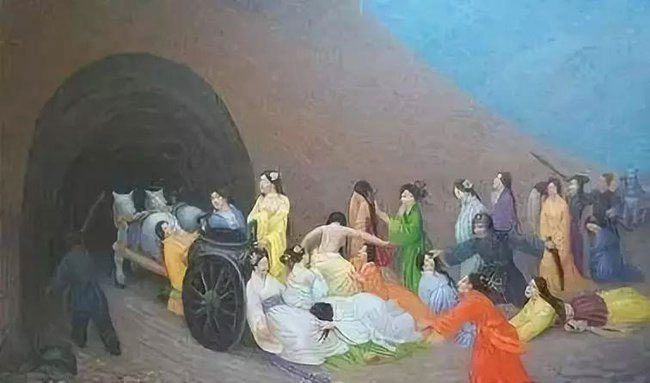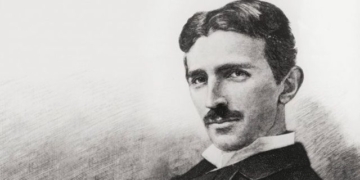Burial practices are one of the most brutal customs in history. Although this practice has been abolished for a long time, the records left by ancient documents still instill fear in future generations.
The Truth About Burial Practices
This custom in China originated from the belief that burial practices were meant to ensure that when the emperor passed into the afterlife, he would still have servants as he did in life or to serve as a protective measure.
The burial practice was generally reserved for the highest classes, including emperors and nobles. Those chosen to be buried alongside the deceased would include wives, concubines, or close attendants, as well as slaves. Even the builders of the tombs for emperors could meet a similar fate to keep the secrets of the resting place forever hidden.

A horrifying scene when the emperor died, the concubines were successively buried alive. They wept for their own deaths – (Illustrative image).
According to existing evidence, this burial practice was prevalent during the Shang and Zhou dynasties. In more than a dozen ancient tombs excavated in Anyang, the capital of the Shang dynasty, over 5,000 individuals were buried alive.
Some concubines chosen to be buried with the emperor were rewarded with white silk or poisoned wine. So, when the emperor passed away, the royal harem wailed in despair. They were not weeping for the emperor’s death, but for their own.
When Zhu Yuanzhang (the Hongwu Emperor) died, as many as 46 concubines were buried alive. All were killed first using mercury before being buried, as this kept the bodies from decaying for a long time.
During the Qin dynasty, Emperor Qin Shi Huang began using attendants instead of concubines for burial, but that did not mean the practice of burying concubines ceased at this time.
By the Qing dynasty, when Emperor Shunzhi died, more than 30 concubines were buried alive. Witnessing this, Emperor Kangxi ordered the practice of burial to be abolished.
In ancient China, there were two methods of burial:
- The first was burial after death.
- The second, which was more brutal, involved burying individuals while they were still alive.
The Qing dynasty writer Yan Mai recorded one of the most brutal methods of burial, where the individuals chosen for burial were still alive, nailed to the wall, and left to die slowly in the tomb. There was also another incredibly savage method where the individuals were bound and placed in a specific position before being buried alive.
However, perhaps the most horrifying part was the waiting period before death, which is why those chosen for burial often requested to die before being interred.
According to Sohu, within the tomb, a number of individuals were assigned the task of “ending” the lives of those to be buried when they were taken into the tomb. Therefore, it was rare for those chosen for burial to wait for death inside the tomb.

Burial can mean burying the living alongside the dead – (Illustrative image).
There are also opinions suggesting that if there were cases where those chosen for burial were still alive in the tomb and the number of individuals was no more than 18, they might survive for about three days, but that three days would be like hell. If the number rose to between 18 and 56 individuals, the lack of oxygen would likely mean survival time would only be about one day.
Archaeologists have discovered a tomb from the Shang dynasty in Anyang, Henan, China, which features a scene that can only be described as tragic.
In that tomb, the burial victims lay at the bottom, covered by earth to form a foundation. They had to struggle in vain due to the lack of oxygen and ultimately died. When the remains were found, they were in very unusual positions. Their limbs could not stretch out like those of ordinary corpses.
The Most Horrific Cases of Burial
While alive, each time he conquered a small state, Qin Shi Huang would bring beautiful women into his harem. Therefore, when Qin Shi Huang died, many concubines and beautiful women were also buried alive with him. Sima Qian’s Records of the Grand Historian describes the pitiful state of the concubines who had to be buried with Qin Shi Huang as being horrifying: “The cries shook heaven and earth, and anyone who heard it would be terrified.”
Additionally, after the tomb was completed, many individuals who participated in the construction of Qin Shi Huang’s tomb were also buried alive inside to keep the secrets of the construction hidden. To this day, the exact number of those buried alive with Qin Shi Huang remains an open question.
Archaeologists have found a large number of female skeletons in Qin Shi Huang’s tomb. They determined that these were the remains of the concubines buried with the emperor. What is most remarkable is that the leg bones of most of the female skeletons were not closed.
After a period of study, scientists found the reason for this phenomenon. In such a terrifying environment, the concubines chosen for burial must have desperately struggled for their lives, crying out in pain, and ultimately died from lack of oxygen. Therefore, the corpses of these women, after death, were in very strange positions, either curled up and twisted or unable to close their legs or stretch out like normal.
In 1398, when Emperor Zhu Yuanzhang passed away, his descendant Zhu Doanwen ascended to the throne. Following the last wishes of the late emperor, Zhu Doanwen ordered that all 46 concubines who had never borne children be buried with the Ming Founder Zhu Yuanzhang. The order, once issued, threw the court into chaos. Wails of mourning echoed everywhere.
The concubines of the royal harem, placed on the list for burial after receiving Zhu Yuanzhang’s order, were taken to a room furnished with chairs known as “taishi yi” (Grand Preceptor’s Chair), where a rope measuring seven zhang (1.3m) was already prepared. Some would stand up to place their necks in the rope and kick the chairs away, while others, too frightened, would be assisted by the eunuchs.

The concubines were given white scarves or poisoned wine to end their lives – (Illustrative image).
According to legend, when Zhu Yuanzhang was buried, a “maze” was established. On the same day, the 13 main gates of the capital city were opened simultaneously to transport the coffins of the concubines to the tomb. According to feng shui beliefs, this was a technique used to blind the eyes of onlookers during the burial. This way, it was possible to thwart grave robbers. The tombs of the concubines buried alive were also used to mislead grave robbers, ensuring the eternal rest of the emperor would not be disturbed.
To comfort the families of the concubines, Zhu Doanwen, the grandson of Zhu Yuanzhang, who inherited the throne from him, promoted the high-ranking officials whose daughters were chosen for burial to the titles of “tian hou” (heavenly protector), “bai hou” (hundred protector) and allowed them to pass down their titles to their descendants.
- Burial practices: Concubines forced to drink poison, mercury poured over them, and many brutal methods before being buried alive with the emperor
- How long can those buried alive survive in the tomb?
- Discovery of a pregnant woman buried in the tomb of Qin Shi Huang: Is she the bloodline of the emperor?


















































